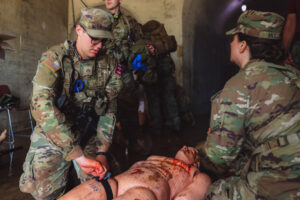
Story by Sgt. Mebea Demelash
222nd Broadcast Operations Detachment
FORT CAVAZOS, Texas — The Joint Emergency Medicine Exercise, JEMX culminates with tactical medical lanes, which began June 4, 2024, and will continue until June 6, 2024. Participants of the exercise will demonstrate and execute what they have learned from the week of training.
This year’s JEMX kicked off on June 2, 2024, welcoming military medical professionals from across the U.S., along with visiting partner nations from the Netherlands and the United Arab Emirates Armed Forces. The next day, army medical professionals from the Carl R. Darnall Army Medical Center, CRDMAC, which coordinates the annual exercise, gave the participants a welcome brief and didactics. JEMX dedicated day two to familiarization with Tactical Combat Casualty Care, TCCC, and medical preparatory lanes.
Today, the participants used what they learned and practiced in tactical lanes with different scenarios. The lanes are divided into three, based on the medical roles in the U.S. military. The first role provides immediate, front-line care by combat medics, focusing on basic emergency treatment and stabilization. The second role offers enhanced care near the front lines, with advanced trauma management and resuscitation by forward surgical teams. The last role involves comprehensive hospital care within the theater of operations, provided by combat support hospitals, offering full surgical capabilities, intensive care, and specialized diagnostics.
U.S. Army Capt. Vanessa Hannick, assigned to CRDAMC as an emergency physician and deputy medical director for JEMX, mentions that many participants come from hospitals and have never experienced point-of-injury care or the various levels of care in the field.
“By bringing them to JEMX, we provide them with the opportunity to experience all levels of care, from point-of-injury to evacuation and en route care,” said Hannick. “This exposure allows them to understand the different types of medical procedures performed at each level and their capabilities and prepares them to work effectively in any of these environments.”
Through these lanes, JEMX strives to improve the cooperation between the U.S. military and partner nations’ medical teams. Additionally, it provides a platform for participants to exchange best practices and gain insights from each other’s experiences.